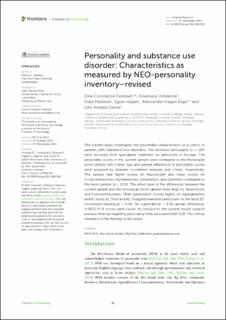| dc.contributor.author | Grude Fodstad, Elise Constance | |
| dc.contributor.author | Ushakova, Anastasia | |
| dc.contributor.author | Pallesen, Ståle | |
| dc.contributor.author | Hagen, Egon | |
| dc.contributor.author | Erga, Aleksander Hagen | |
| dc.contributor.author | Erevik, Eilin K. | |
| dc.date.accessioned | 2022-12-19T15:10:57Z | |
| dc.date.available | 2022-12-19T15:10:57Z | |
| dc.date.created | 2022-12-04T13:59:43Z | |
| dc.date.issued | 2022-11-07 | |
| dc.identifier.issn | 1664-1078 | |
| dc.identifier.uri | https://hdl.handle.net/11250/3038672 | |
| dc.description.abstract | The present study investigates the personality characteristics of a cohort of patients with Substance Use Disorders. The included participants (n = 123) were recruited from specialized treatment for addictions in Norway. The personality scores in the current sample were compared to the Norwegian norm sample with t-tests. Age and gender differences in personality scores were assessed by bivariate correlation analyses and t-tests, respectively. The sample had higher scores on Neuroticism and lower scores on Conscientiousness, Agreeableness, Extraversion, and Openness compared to the norm sample (p < 0.01). The effect sizes of the differences between the current sample and the Norwegian norm sample were large for Neuroticism and Conscientiousness. Older participants scored higher on Agreeableness and its facets A1: Trust and A2: Straightforwardness and lower on the facet E5: Excitement-Seeking (p < 0.01). No significant (p < 0.01) gender differences in NEO-PI-R scores were found. In conclusion, the current results support previous findings regarding personality traits associated with SUD. The clinical relevance of the findings is discussed. | en_US |
| dc.language.iso | eng | en_US |
| dc.publisher | Frontiers | en_US |
| dc.rights | Navngivelse 4.0 Internasjonal | * |
| dc.rights.uri | http://creativecommons.org/licenses/by/4.0/deed.no | * |
| dc.title | Personality and substance use disorder: Characteristics as measured by NEO-personality inventory–revised | en_US |
| dc.type | Journal article | en_US |
| dc.type | Peer reviewed | en_US |
| dc.description.version | publishedVersion | en_US |
| dc.rights.holder | Copyright 2022 the authors | en_US |
| dc.source.articlenumber | 982763 | en_US |
| cristin.ispublished | true | |
| cristin.fulltext | original | |
| cristin.qualitycode | 1 | |
| dc.identifier.doi | 10.3389/fpsyg.2022.982763 | |
| dc.identifier.cristin | 2088265 | |
| dc.source.journal | Frontiers in Psychology | en_US |
| dc.identifier.citation | Frontiers in Psychology. 2022, 13, 982763. | en_US |
| dc.source.volume | 13 | en_US |

